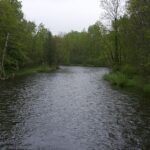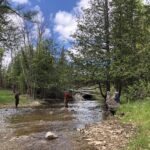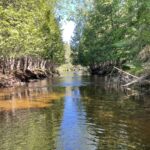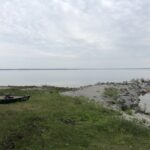Description:
The Black Lake Watershed is well known for its recreational opportunities and aesthetic appeal. Boating, swimming, and fishing are popular activities among year-round residents, seasonal residents, and tourists. Not only is Black Lake itself heavily utilized, but many tourists come to the area to enjoy the Pigeon River Country, hunting, fishing, and canoeing/kayaking opportunities afforded by the Black River.
Black Lake has a healthy and diverse fishery resource. The Lake is famous for its population of lake sturgeon that is self-sustaining, but is threatened. A very limited fishing season, every February, allows for five lake sturgeon to be harvested. The Lake’s fishery also includes muskellunge, northern pike, yellow perch, walleye, and bass.
The major rivers within the watershed are also important recreation areas. Canada Creek has a community of permanent and seasonal residents, called Canada Creek Ranch, who mostly live along the riverbank or on the shoreline property of Lake Geneva and the other small lakes within the development. Kleber and Tower Ponds on the Upper Black River also are heavily used for recreation. Tomahawk Creek, Canada Creek, and the East Branch of the Black River are located in areas favored by hunters and anglers, as well as hikers and campers.
The Pigeon River Country State Forest encompasses about 120 square miles, much of which is in the Black Lake Watershed. It is the largest contiguous block of state-owned land in Michigan’s Lower Peninsula. The area is managed separately from other state forest lands in the area. Because of the unique features within the forest (Michigan’s only elk herd, numerous high quality rivers and lakes, and the wilderness atmosphere of the area), more protective land and water management policies are in place than on most state forest lands. Work is ongoing to preserve, protect, and enhance the wildlife corridors and habitat in the area outside of the boundaries of the Pigeon River Country State Forest.
Geographic Description:
Several rivers and streams flow into Black Lake. The major tributaries to the Lake are the Upper Black River (57 river miles) and the Rainy River (24 river miles). Additionally two major rivers flow into the Upper Black and indirectly into Black Lake: Canada Creek and the East Branch (21 river miles each). Other important tributaries include Tomahawk Creek, Milligan Creek, Stony Creek, Mud Creek, Hardwood Creek, Van Hellens Creek, Rattlesnake Creek, Packer Creek, and Fast Creek. Numerous smaller streams also flow into Black Lake and its tributary rivers.
The watershed contains mostly forested and open space, much of which is state land. Agriculture uses comprise a relatively small percentage of the entire watershed. Besides Onaway, Canada Creek, and Tower there are minimal amounts of urban areas mostly
contained in several small communities and strips of residential development along roads and shorelines.





